About a year ago, I had the idea of running film through a couple of borrowed 110 cameras and possibly writing up a review. This seems to have ended up as a mini odyssey around the world of subminiature photography, taking in such notable cameras as the Canon 110 ED, Minox 110S, Rollei A110 and a selection of 16 mm cameras. Recommendations from commenters on previous articles led me to the Pentax Auto 110. It isn’t a bad place to have ended up.
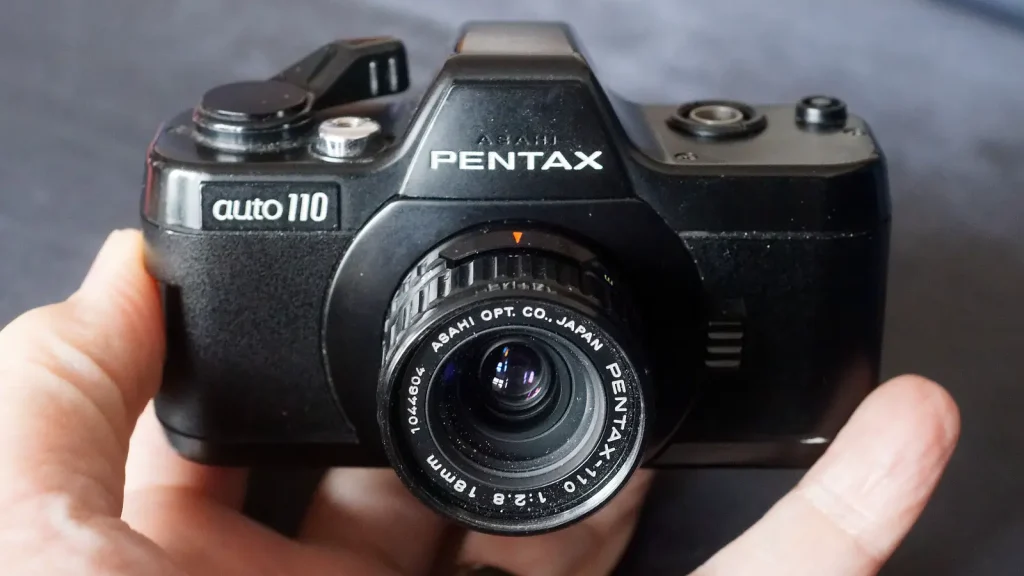
Pentax in the late 70s
Some context might be useful here. Back in 1978 Asahi’s Pentax brand was on a roll. Two year before they had released their original ‘M’ 35 mm SLR bodies: two cameras that covered a lot of ground. These were the genuinely affordable professional ‘MX‘ body and the rather revolutionary, consumer focused ‘ME‘. The ME was revolutionary in not having manual speeds – relying purely on aperture priority automatic exposure. On top of that, it pipped the Olympus OM1 to be the smallest 35mm SLR ever.
Old-timers, already unimpressed by auto exposure, scoffed some more at the ME. But the public loved it: it was small and pretty; capable yet simple in operation.
One by one, competitors brought out their versions of auto only SLRs, with even Nikon producing its first camera aimed at the consumer, the EM (surely a coincidence?)
Pentax K mount was dominating, it was almost a universal bayonet, being used by a host of camera manufacturers and supported by all the leading third party lens makers.
This was the age of the miniature camera. Small was big, and so was Asahi Pentax. Unusually for a camera company in such a strong position, they carried on innovating.
Origins
The Pentax 110 was based on a design brought in by Asahi.
The original idea seems to have originated in a company called Sugaya Optical, which specialised in subminiature cameras. A Mr Sugaya (who may have previously worked for Nikon) worked up a prototype for a 110 SLR, which he then sold to Asahi.
The Pentax was not the first 110 SLR to the market – that title goes to the Minolta 110 zoom. The advantages of the Pentax are its fast interchangeable lenses (the Minolta had a slower fixed zoom) and its size (the Minolta is not a small camera).
System 10
Asahi launched System 10 (as I had absolutely no recollection at all of it being called) in late 1978. It comprised the Pentax Auto 110 camera, an autowinder, two flashguns and three prime lenses, together with filters, close-up lenses and lens hoods. It was a whole system. I was a photography-mad teenager at the time and remember the Pentax Auto 110 causing quite a stir.
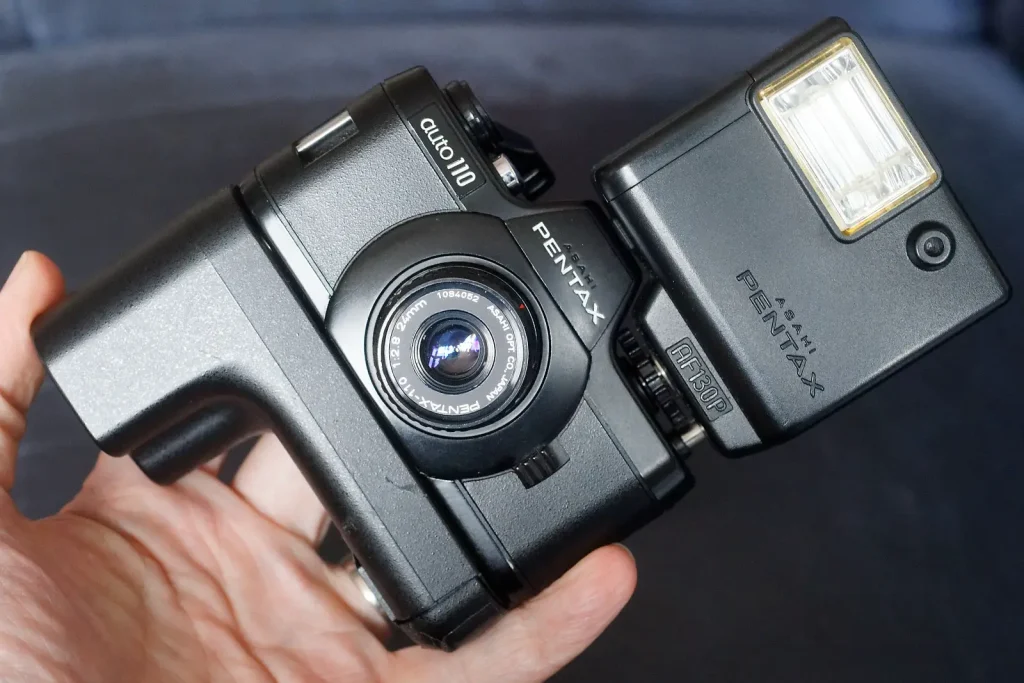
Exposure system
Exposure is metered through the lens by a silicon photodiode. The exposure program runs from f/2.8 at 1/30 to f/13.5 at 1/750. There is no manual option. It is possible to get some degree of differential focus with the 50mm f/2.8, but in the circumstances, program exposure works fine.
The Auto 110 has sensors in the camera body to detect high and low sensitivity film (although at time of writing only low sensitivity film is available). Pentax decided to go for ISO 80 as the low setting (well within the latitude of most 100 ISO film stocks).
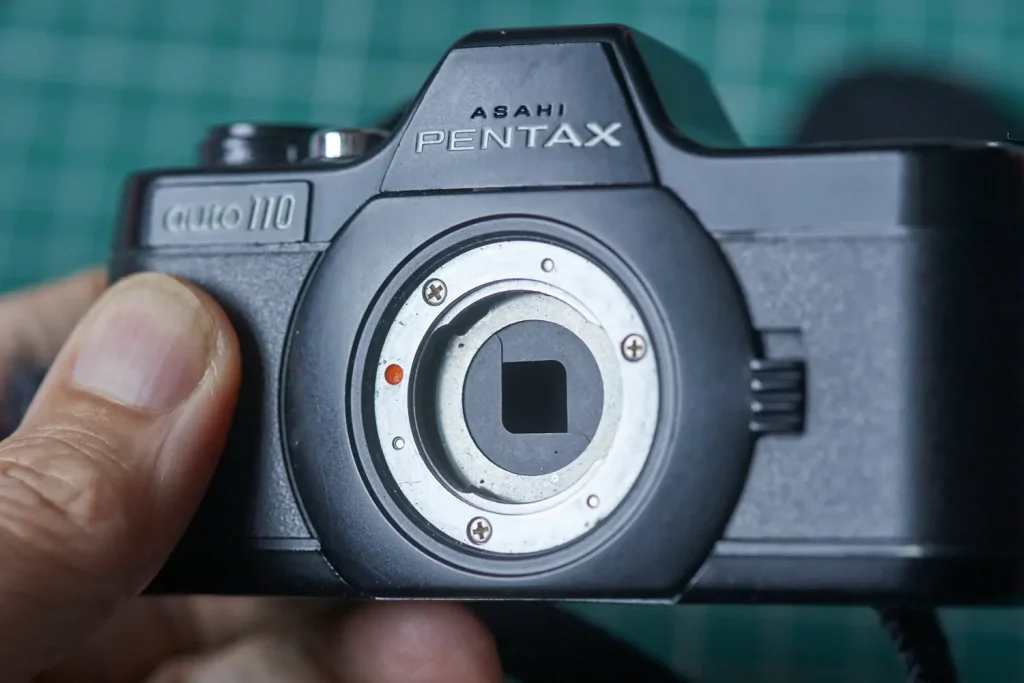
The aperture and shutter are taken care of by a combined unit in the camera body. Two blades form a square-ish aperture immediately behind the lens mount. When the shutter is released, the blades close together to block out light. The mirror (which has been shielding the film from light until now) lifts and the shutter/aperture then opens until it reaches the programmed aperture, at which point is starts to close again. Once it has closed fully, the mirror can drop back down, protecting the film from light, and the shutter/aperture can reopen.
The shutter will not fire unless a lens is mounted on the camera.
The late 70s was a while before the photographic world became obsessed with bokeh. The shape of the aperture shouldn’t matter too much here, as:
- Wide open the aperture will be round.
- Unless you are using a telephoto, it is difficult to get a background too much out of focus.
The diaphragm moving during the exposure also makes hard edged bokeh less likely.
Viewing, shooting and winding on
Focus is via an SLR viewfinder which is a decent size for a 110 camera and features a big split-image rangefinder. It is probably the best viewfinder I’ve come across in a 110 camera. Exposure information is limited to an LED in the bottom right of the viewfinder, which lights up on a half-press. The LED shows green for higher shutter speeds (above 1/30) and amber for low ones (below 1/30). The shutter is only supposed to extend down to 1 second, but the camera seems capable of exposures up to 4 seconds.
The shutter release itself is broad and comfortable, and is threaded for a cable release.
Film wind-on (presuming you are not using the autowinder) is via a two stroke lever on the top-plate.
Lenses
All the lenses are reasonably fast (f/2.8) which some say is mandated by the body-mounted diaphragm and exposure system. They fit onto the body via a two-winged bayonet. The wings are sized so that you cannot put the lens on the wrong way around. The twist to lock is about 90 degrees and a lens release is on the left side of the mount. The lenses contain a helicoid for focusing, but do not contain any other mechanisms. This is just as well, because there is no room for any. These tiny lenses are filled up with glass. They also focus surprisingly close.
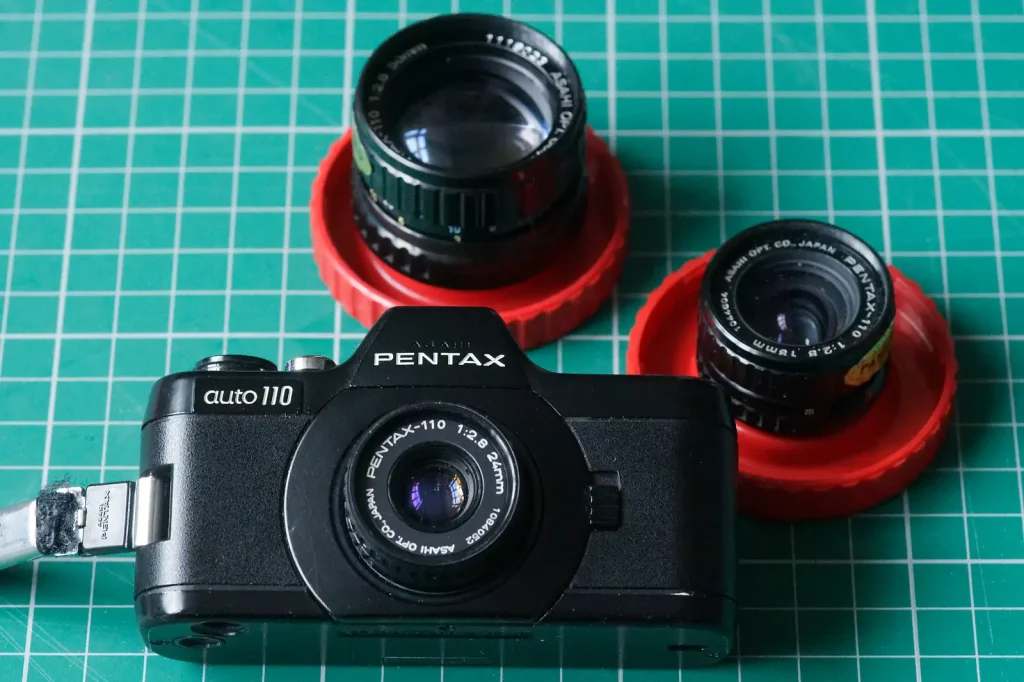
18 mm is not very wide, but at 36 mm equivalent, it is about as wide as you will find in a mainstream 110 camera. The 24 is quite reasonable for a standard and the 50 (which looks huge on the camera, but is still very small) is a reasonable telephoto.
A fixed-focus version of the 18 mm lens was also produced, along with a focusing 70 mm and a 20-40 mm zoom. In addition to the Pentax lenses, Soligor produced a 1.7x tele-converter for the system.
The successor
In 1983 Asahi introduced a revised model called the Pentax Auto 110 Super. It featured a brighter viewfinder, a single-stroke film advance, a self-timer, a shutter lock, a tethered flash cover and a backlight compensation switch. Pentax reduced the top shutter speed to 1/400, but the aperture went down to f/18 to compensate. A new version of the autowinder, capable of continuous shooting, was also produced.
The Pentax Auto 110 In use
Size & Shape
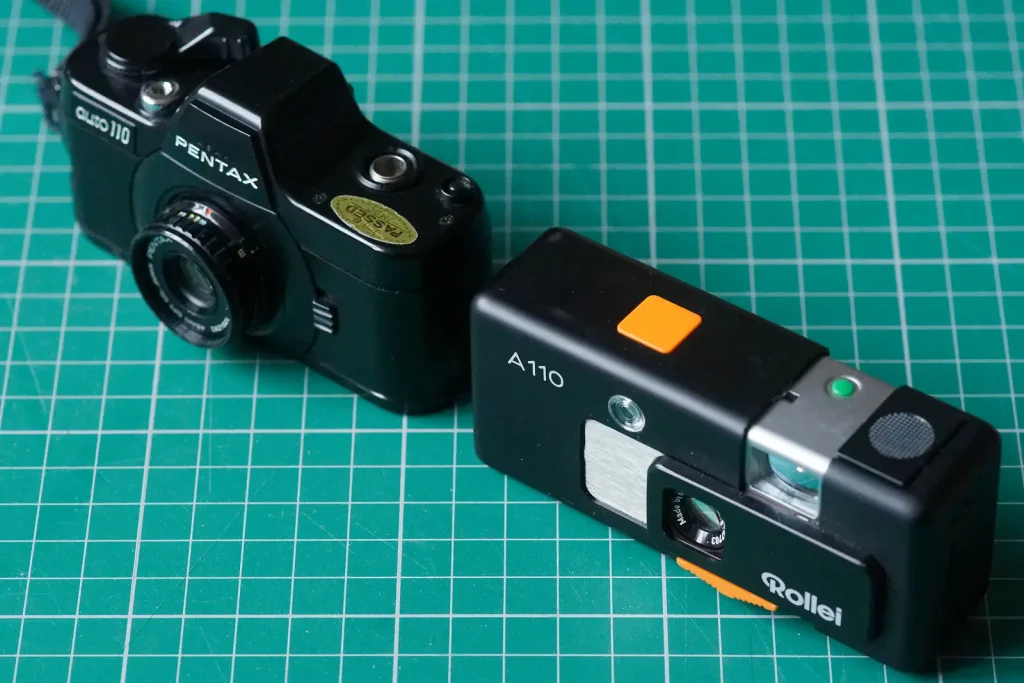
Size-wise, it is difficult to see how a 110 camera with a reflex viewfinder and interchangeable lenses could be smaller. In comparison to the Rollei A110 the only bits that protrude beyond that camera for height are the wind-on lever and pentaprism hump, while the extra depth is entirely down to whichever lens you have fitted. With form following function, the Auto 110 itself is a bit of a blobby block: if anything confirms the non-Pentax origins of the design, it is this lack of elegant lines.
Flash
The Auto 110 does not have a hot shoe. Instead it has a couple of dedicated flashguns that bolt on to the top left of the camera. The process of fitting the flash is a little fiddly. Flash is direct and controlled by a sensor on the flashgun. The camera senses when the flash is turned on and sets itself up for 1/30 at f/2.8 for low speed film, or 1/30 at f/5.6 for high speed film.
Winder
The winder will advance film on a single shot basis at up to 1 frame per second. Mine sounds like a strangled cat in operation. In practical terms, it gives a bit more real estate to hang on to for those who find the Auto 110 too small for comfortable handling.
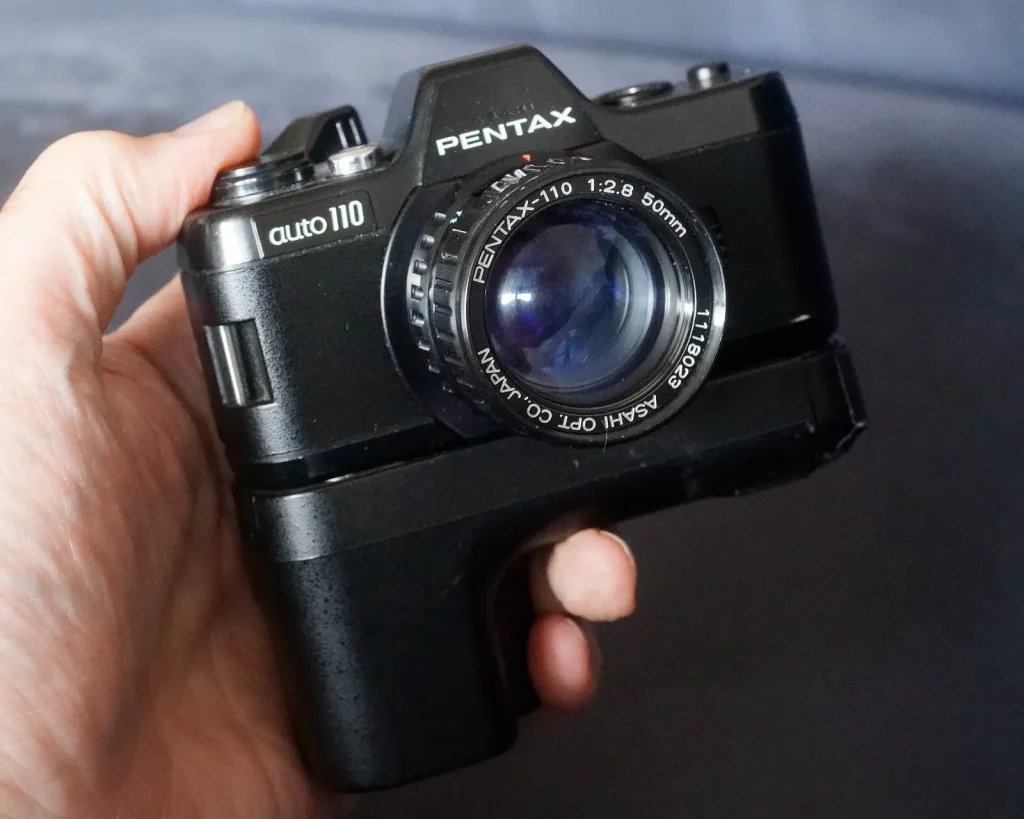
Pictures
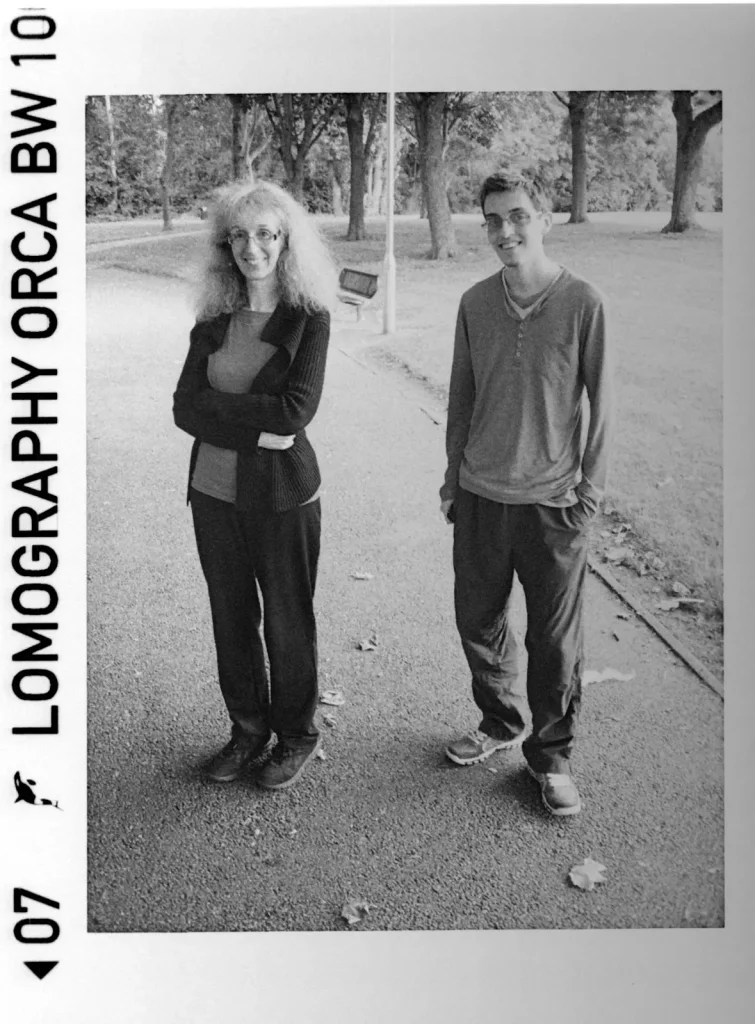
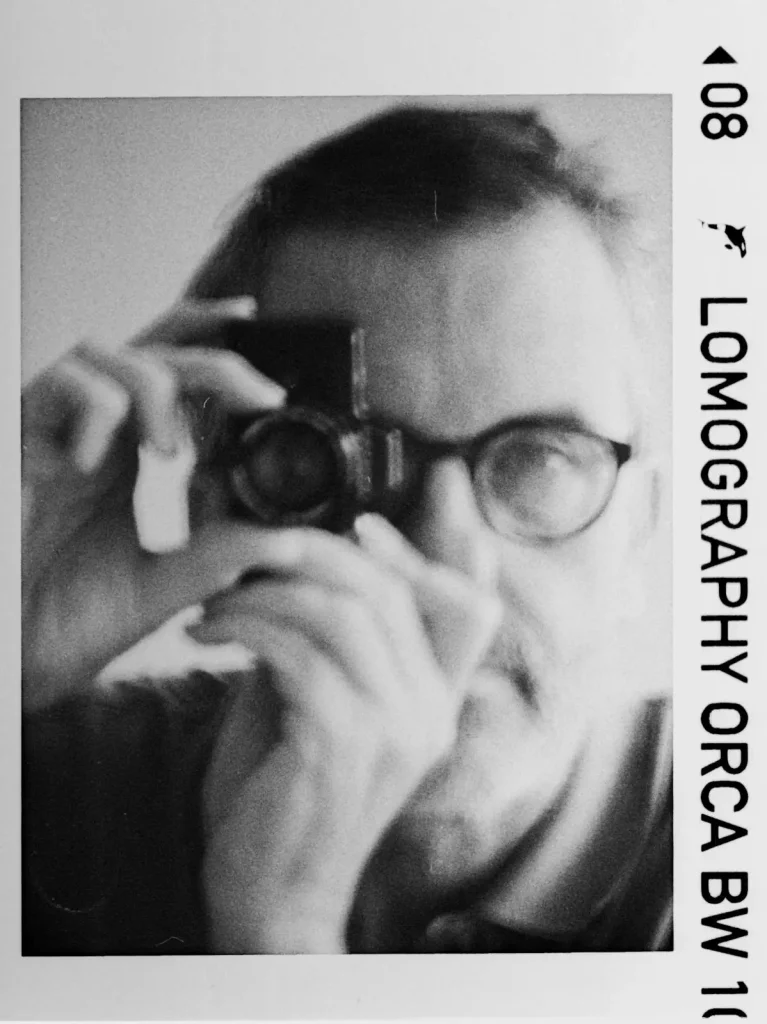
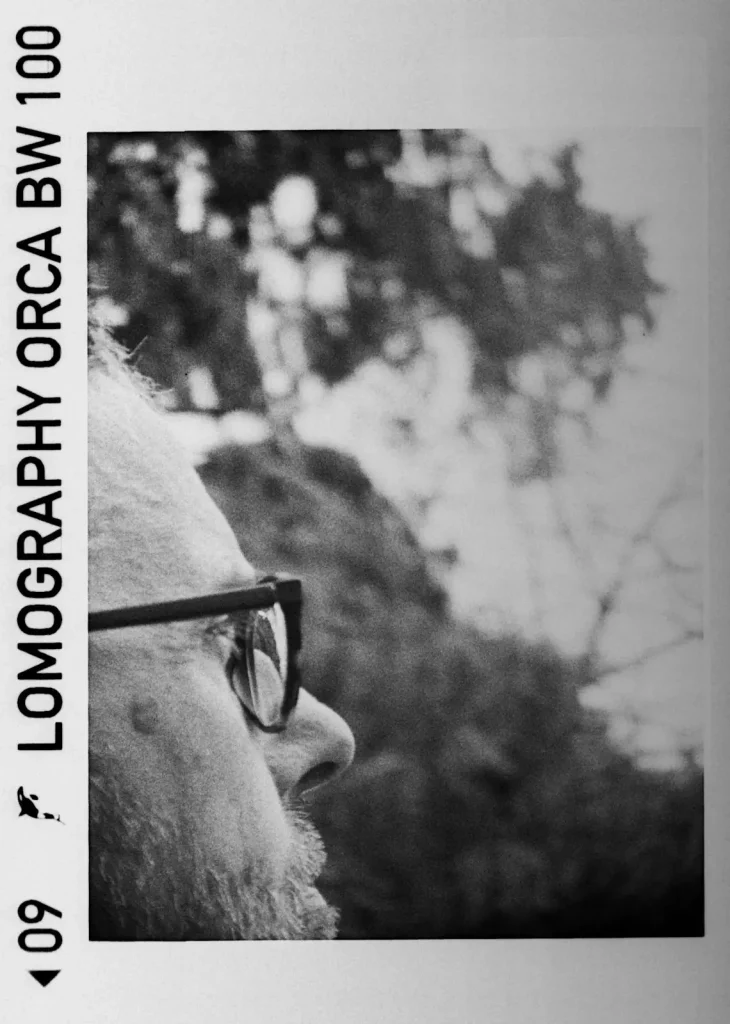
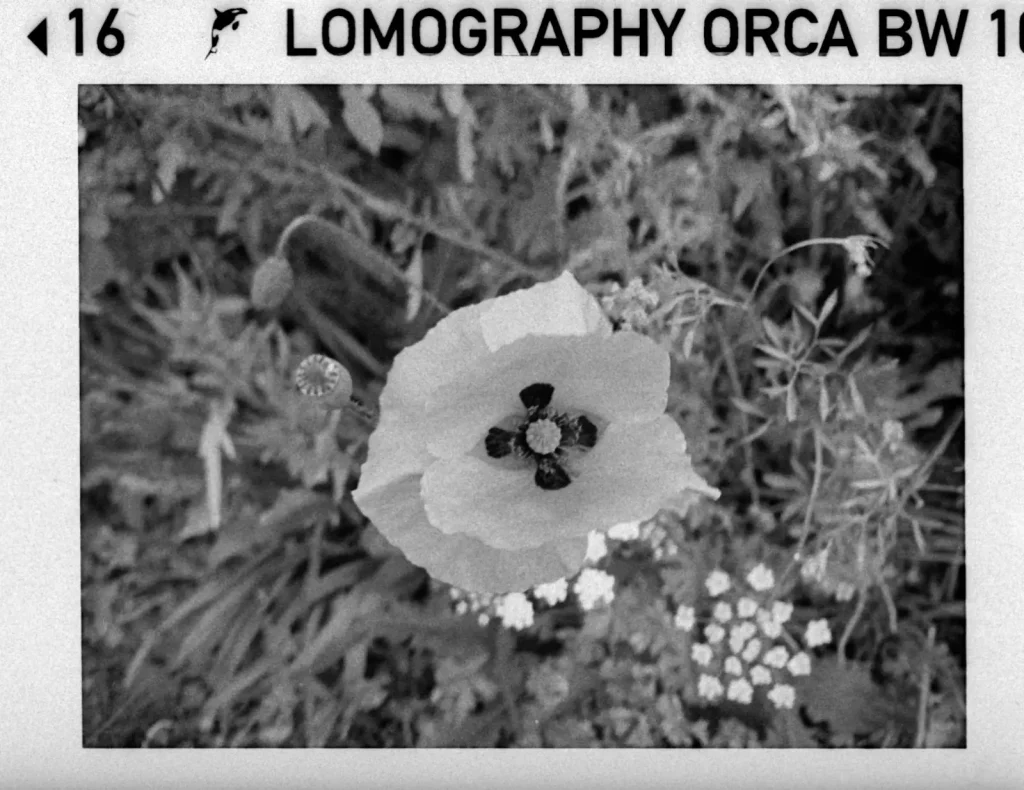
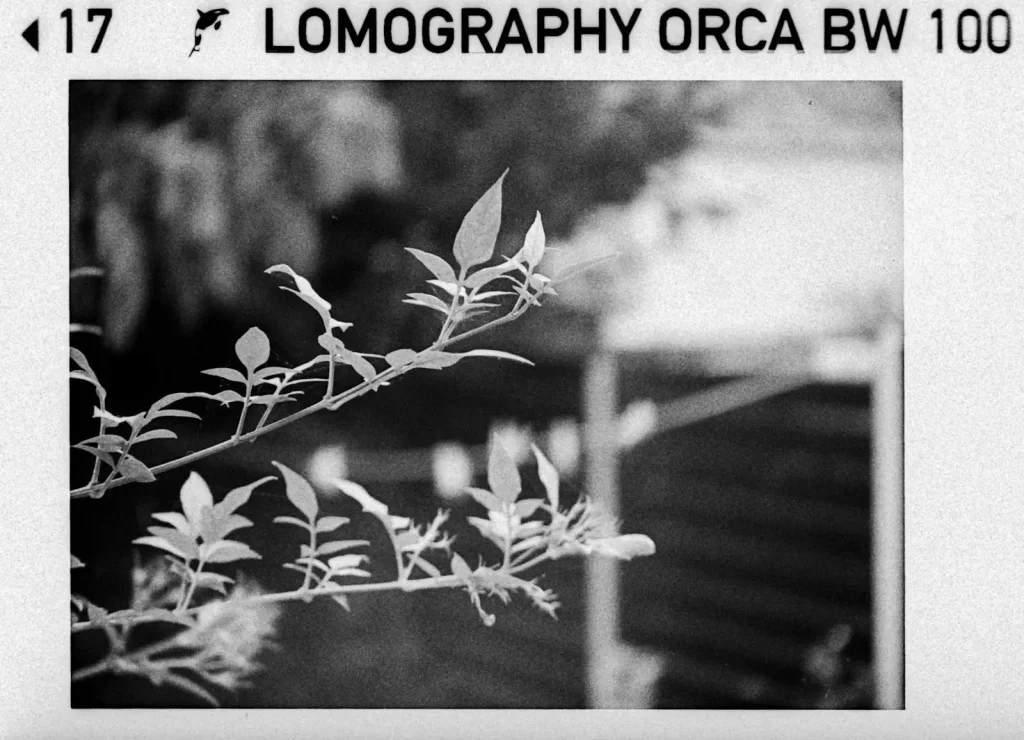
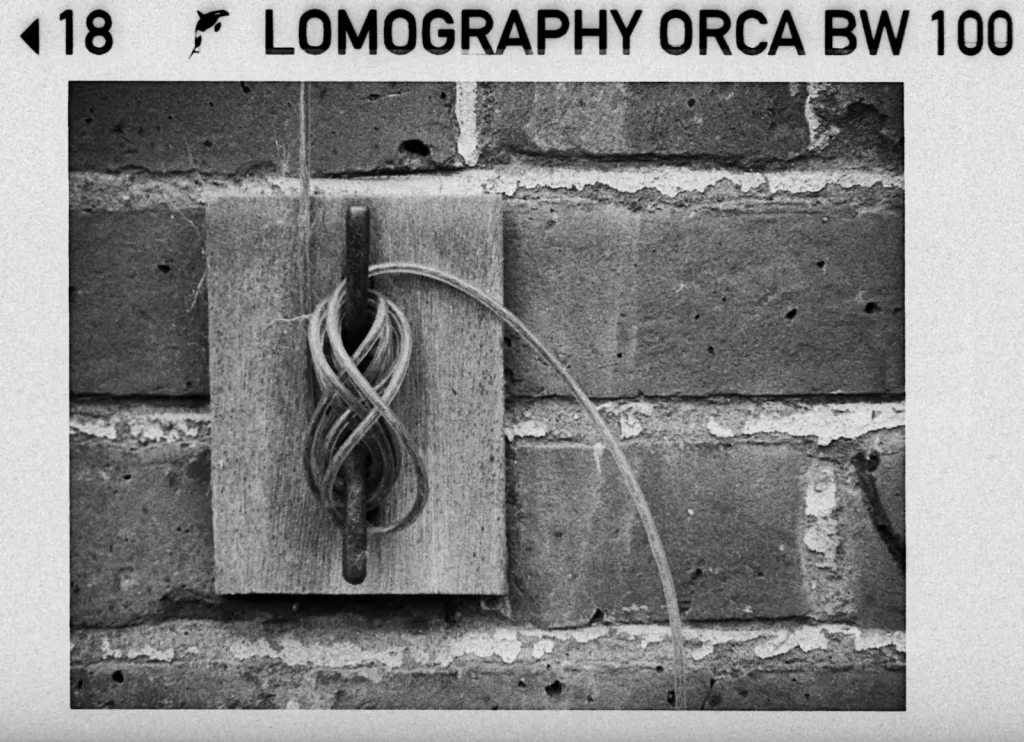
Conclusion
There are a couple of minor niggles. The cover for the flash contact on the top plate seems to go missing easily (mine is long gone), and the battery door on the autowinder is a weak point. Expect to see the door held closed with insulating tape.
The only extra control that would be really useful would be an exposure lock.
It takes readily available 1.55v silver oxide batteries. Finding film and processing are likely to be the only real problems in practice.
This is about as go-anywhere as an analogue camera gets. Forget the winder and the flash, just slip the camera into one pocket and a handful of lenses in the other. Your creative options are huge. The reflex viewfinder is a great compositional tool.
On the whole, the Pentax Auto 110 is very usable. I can’t quite work out why it has taken me over 40 years to try one out, but I’m glad I got there in the end.
Share this post:
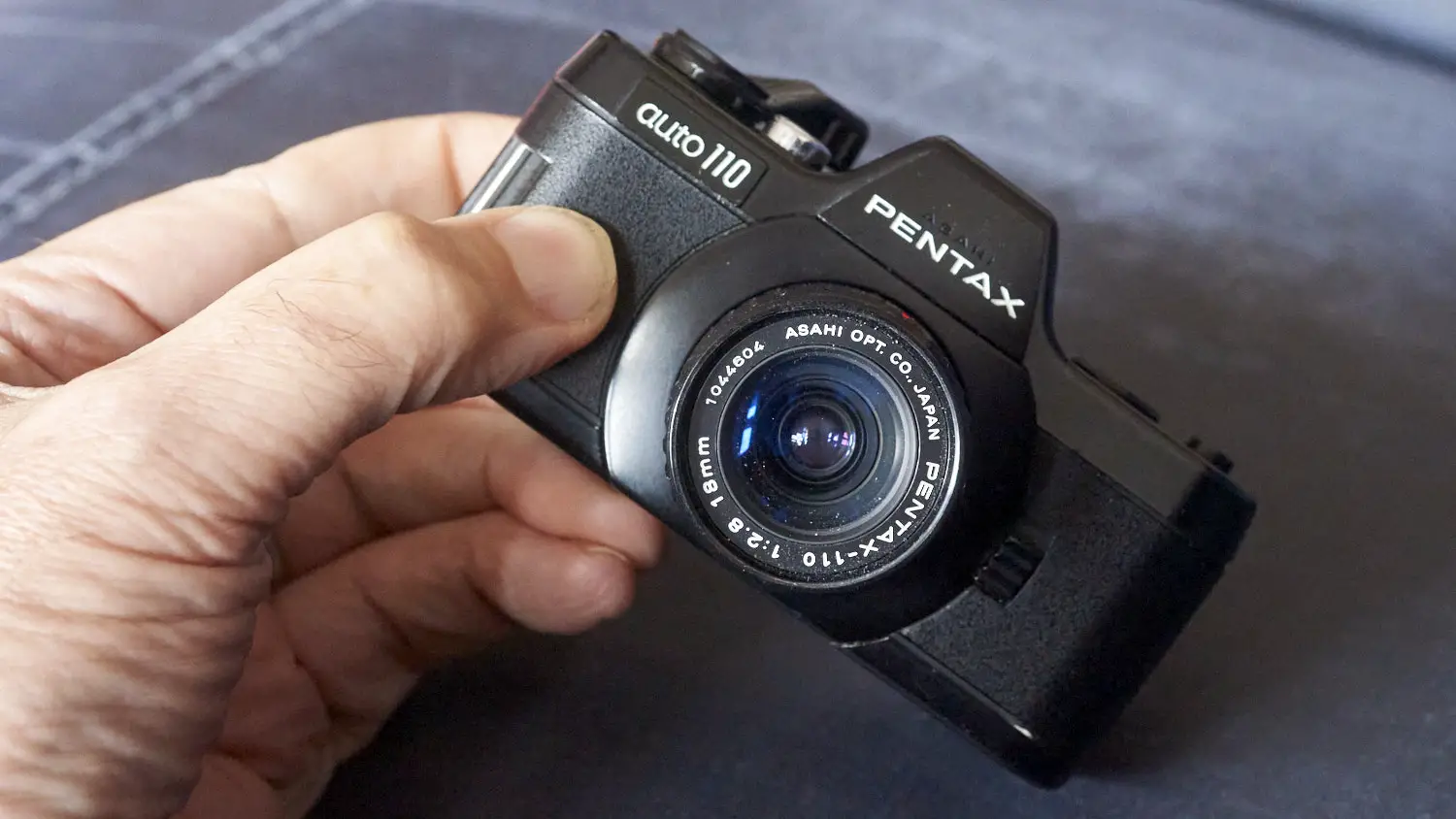








Comments
Martin on Pentax Auto 110 Review – By Bob Janes
Comment posted: 19/10/2021
Personally I like the Minolta 110 Zoom SLR Mk. 2 better, it's a bit larger the lens is sharper IMO and no need to fiddle with changing lenses (yes, I have Zoom for the Pentax).
Thanks again for sharing your impressions of that fine little camera and
best regards
Martin In Austria
Comment posted: 19/10/2021
Craig Schroeder on Pentax Auto 110 Review – By Bob Janes
Comment posted: 19/10/2021
Comment posted: 19/10/2021
Neal A Wellons on Pentax Auto 110 Review – By Bob Janes
Comment posted: 19/10/2021
I had a Minolta Zoom 110 SLR that I used at the same time with my Pentax. I didn't like the odd ergonomics and large size of the Minolta so I sold it a year or two ago. I'll never sell the Pentax.
Comment posted: 19/10/2021
Alan Chin on Pentax Auto 110 Review – By Bob Janes
Comment posted: 19/10/2021
..and they will cover aps size sensors as well (with a little vignetting or not depending on the lens). No aperture control on these adapters but always being f/2.8 isn’t the end of the world.
Comment posted: 19/10/2021
davesurrey on Pentax Auto 110 Review – By Bob Janes
Comment posted: 21/10/2021
I still have the Auto 110 with all the lenses including the zoom and 18mm pan-focus and have added an Auto 110 Super recently. It really was a system camera with filters, lens hoods etc.
But the one regret/weakness was that being 110 format film processing labs often treated it as if it came out of a “mum and pop snap-matic cheapo” 110 camera. It was and still is capable of a lot better results than that.
CARLTON PHELPS on Pentax Auto 110 Review – By Bob Janes
Comment posted: 21/10/2021
I like keeping the Pentax in the pocket for a quick shot. I bought an adapter for my Sony 6000a, so I can also try the lens with digital.
The only complaint I have is with film processing. Dang, most places charge $18.
I also sold a set up of the Pentax 110 on eBay, and that paid for both cameras and lens.
I'll try and get a few shots soon with the Sony and share if allowed.
Pál_K on Pentax Auto 110 Review – By Bob Janes
Comment posted: 23/10/2021
People whose most important consideration is owning the newest equipment and the obtaining the highest image resolution, will never be able to appreciate the beauty of the images this camera can produce, nor know the joy of using this nice little system.
From this camera I have many very beautiful 4x6” prints framed and hanging on a wall of y home. Although I have very many 35mm, medium format, large format, and digital cameras, this subminiature format camera is just as much fun to use and, if know how to make a nice photo regardless of the equipment, this camera won’t really limit you.
I am fortunate enough that a camera-repair friend sold me almost the entire Pentax 110 system for little money: a Pentax custom aluminum kit-case, the camera, all the lenses except the zoom, plus close-up attachments, filters, the flash, and motor drive.
Usually I’ll carry the camera either alone with one lens, or with three lenses in a very small pouch attached to my belt. I can walk around the city and neighborhood, go to shops, the waterfront, and make photos with this camera all day long with great convenience.
I did have a slight film-flatness issue with 3rd-party reloaded film, though it wasn’t bad enough to spoil the image. I’ve thought about fabricating a small shim that could be inserted between the film and the back of the cassette - one drawback to both 110 and 126 film cassettes is there’s no pressure plate to ensure flatness. Overall, however, I am very pleased with what the Pentax 110 can do.
Comment posted: 23/10/2021
How Do You Know When A Film camera Is Out of Film? – The Photography Professor – Film Photography How To and Help on Pentax Auto 110 Review – By Bob Janes
Comment posted: 26/07/2022
Ibraar Hussain on Pentax Auto 110 Review – By Bob Janes
Comment posted: 21/05/2023